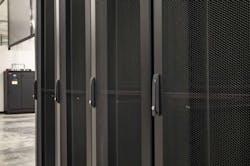The Colocation Data Center’s Role in Healthcare
Sabey Data Centers’ John Sasser, Sr. Vice President of Data Center Operations, highlights how in light of the recent coronoavirus pandemic it’s even more important to understand where big data, and data-driven computer models can help enhance efficiency and accuracy in today’s healthcare institutions. Explore the potential of the colocation data center in healthcare.
John Sasser, Sr. Vice President of Data Center Operations
As the COVID-19 virus has impacted almost every way of life around the globe, it is heartening to know that we’re living in an age where data-driven computer models can complete certain medical tasks more accurately than doctors.
For instance, a recent study published in the journal “Nature” found that artificial intelligence is more accurate than medical professionals at diagnosing breast cancer through mammogram analysis. The AI program reduced false negatives by 2.7% and false positives by 1.2%.
Healthcare IT spending increases every year, and not just in the realm of AI-based diagnostics. Medical organizations are exploring a brave new world of data-driven healthcare, with initiatives ranging from predicting such catastrophic epidemics as COVID-19 to improving preventive care for the chronically ill. One hospital in California even made national headlines after it used predictive analytics to cut patient falls by 39%. Clearly, information technology is creating opportunities to drive better healthcare outcomes at a lower cost to patients—and data is the foundation of these opportunities.
But behind every byte of data is a network of fiber-optic cables, servers, switches, racks, cooling equipment, power distribution infrastructure and other systems that ensure the safe passage, processing, and storage of electronic health information (EHI).
Data centers are the engines for many of our greatest healthcare IT accomplishments. And while healthcare companies, software developers and data analysts collaborate on new medical innovations, colocation data centers providers can deliver the behind-the-scenes support for these groundbreaking healthcare IT initiatives, especially during times of crisis.
Extending colocation’s benefits to healthcare
Unlike traditional on-premises data centers, colocation data centers maintain and optimize core facility infrastructure such as power, networking, cooling and space. Many colocation providers also offer remote support for the IT load (servers, switches, etc.).
There are a few advantages to this setup. Firstly, healthcare providers, EHR vendors, software developers, investment groups, life-science researchers and other potential health IT stakeholders are free to focus less on data center management and more on their core competencies: medical research,innovation, and even crisis management.
While its overwhelming consumption of healthcare resources is only temporary, the COVID-19 pandemic is underscoring the herculean efforts that are routinely expected of our healthcare industry as a whole.
Secondly, leasing space from a data center that has been designed and built by specialists is much easier than attempting to own and operate an on-premises facility. There aren’t any land purchases or construction-related capital expenditures—just the cost of energy and space, both of which are methodically managed for optimal efficiency by expert operations teams and technicians.
Thirdly, the best colocation data centers are designed, built and operated to support HIPAA- and HITECH compliance. Data center infrastructure is hardened against potential sources of downtime like environmental hazards and physical intrusions. Ensuring that health records and other medical information are accessible to authorized parties when they need it requires data center resilience and robust network connectivity.
Finally, there are the matters of efficiency and scale. From biotech to lab diagnostics to population management, the more money that a healthcare-oriented firm can funnel into its core competencies, the better. Data centers are an essential source of overhead, but one that can be slimmed down with the help of a colocation provider that prioritizes energy efficiency. By reducing the total cost of ownership without sacrificing facility performance, businesses get more bang for their buck and have opportunities to reinvest savings back into their primary ventures. Healthcare organizations also salvage more of their real estate, a precious commodity, by housing their IT infrastructure off site.
In that same vein, the costs of scaling can add up fast in an on-premises data center. Moving to the cloud is one possible pathway to on-demand scalability, but that can come at the expense of visibility into your IT ecosystem. A modularly designed colocation data center makes it easy for tenants to expand their footprint incrementally, and on a relatively short-term contractual basis. This flexibility gives healthcare and life sciences companies license to scale quickly and with a relatively clear idea of how much it will cost.
Better healthcare is an all-hands-on-deck effort
While its overwhelming consumption of healthcare resources is only temporary, the COVID-19 pandemic is underscoring the herculean efforts that are routinely expected of our healthcare industry as a whole. Through the development of early diagnostic technologies, data-driven preventative care, predictive analytics and digital medication management strategies, healthcare innovators and life sciences companies are working toward the collective goal of improving healthcare outcomes while, ideally, reducing costs for patients.
A colocation provider’s role in this endeavor is to supply HIPAA-compliant colocation services that are scalable, modular and suited to the unique specifications of companies across the care continuum. Regardless of your place in healthcare—a provider with vast quantities of archived health data, a diagnostics company on the cutting edge of data-driven imaging, an enterprise ERM provider, etc.—you should expect your selected partner to support your core competency by lending theirs: colocation data center management.
John Sasser is Sr. Vice President of Data Center Operations at Sabey Data Centers.

